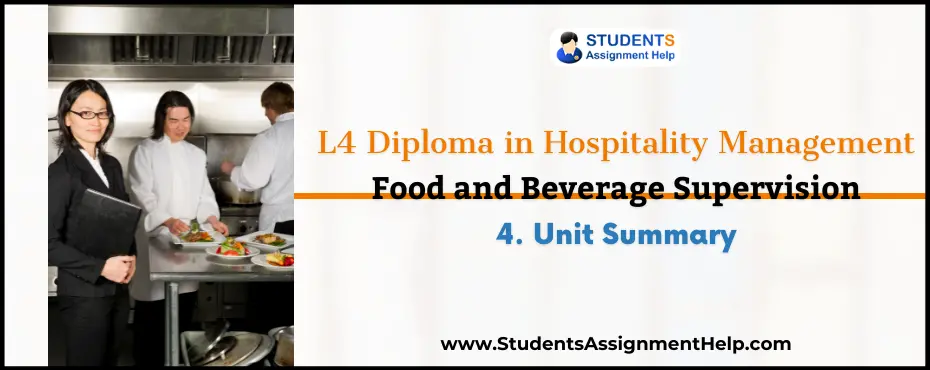L4 Diploma in Hospitality Management: Food and Beverage Supervision 4. Unit Summary

Question:
Rationale for Module Summary
This guide aims to provide students with a convenient study summary where key theoretical concepts have been summarised in a concise manner. This is an ideal guide for a student who has studied the lecture notes and is looking for a quick refresh of theory.
Table Of Contents
1 Evaluate the effectiveness of food and beverage operations
1.1 Set realistic criteria for the evaluation of food and beverage operations
1.2 Analyse the efficiency and effectiveness of food and beverage operations
1.3 Analyse the occupational, environmental and human factors that affect hygiene, health and safety
1.4 Evaluate the potential impact of non-compliance with regulatory requirements
2 Develop food and beverage operations
2.1 Allocate human and physical resources that are sufficient to meet objectives
2.2 Define the factors that affect the development of menus and wine lists and recommend changes to meet identified needs and within budget
2.3 Recommend changes to methods of food production and/or food and beverage service that meet identified needs and within budget
2.4 Explain how any changes may influence customers’ perceptions of the organisational brand
2.5 Evaluate the quality of staffs’ selling, customer service skills and the extent of their product and service knowledge
3 Understand how to arrange banquets and functions
3.1 Develop plans for banquets and functions that meet the specification within budget
3.2 Define menus, wine lists, cooking and service methods that are appropriate to the banquet or function
3.3 Address hygiene, health and safety issues for each event plan
3.4 Specify supervision and staffing arrangements for each event that are sufficient to meet the specification
3.5 Evaluate the success of the event against agreed criteria
4 Understand how to supervise the purchasing and storage of food and beverages
4.1 Define purchasing standards appropriate to the item to be purchased
4.2 Analyse the efficiency and effectiveness of the purchasing and storage of food and beverage items
4.3 Specify storage methods that are appropriate to the item being stored
4.4 Specify procedures for the issue of stock that are appropriate to the item
5 Manage the performance of staff in food and beverage
5.1 Agree targets and objectives that align with business needs
5.2 Provide training interventions that meet identified needs
5.3 Allocate and direct work to meet performance targets and quality standards
5.4 Manage underperformance and in accordance with organisational requirements
5.5 Analyse the principles of recruitment and selection of staff
Answer From 2.1 Onwards
Food and Beverage Supervision
2.1. Allocate human and physical resources that are sufficient to meet objectives
Under this section, managerial staff of the Auckland hotel focuses on allocating human and physical resources. For allocating resources optimally, it is desirable for the managers of the concerned hotel to identify, plan and organise food and beverage operations. The planning is considered as the crucial step in allocating human and physical resources. The planning enable managerial people of the Auckland hotel to identify activities, number of operations, number of customers to be catered, variety of production and service methods, storage capacity of the product and many more. All these aspects are analysed and ascertained in detailed manner under planning stage (Arduser & Brown 2005).
The detailed analysis of all these aspects enables managers of the hotel to ascertain quantity and quality of human and physical resources. The human resources means personnel or workforce required for preparing products, serving customers, storage and other tasks. Likewise, physical resources include infrastructure, ambience, facilities, food preparing equipments, machines, etc. contribute in preparing and delivering products to customers.
2.2. Define the factors that affect the development of menus and wine lists and recommend changes to meet identified needs and within budget
There are various factors affecting the development of menus and wine lists at the Auckland hotel. The menu here refers to the list of dishes offered or served to the customers for making appropriate selection as per their choice and taste. The menus and wine lists are prepared in the light of the occasions, time, day or event. It means menus and wine lists are prepared in absolutely flexible manner where necessary changes are done in accordance with time, event and occasion (Oros 2013). For example, menus and wine list are different for cultural events, religious activities, social gathering, formal meetings, etc. The menus and wine lists served in each occasion are meant to honour and appreciate customers’ emotions and feelings associated with each occasion. The different types of menus and wine lists are prepared for catering customer needs in an effective manner and retaining them for longer period. In light of this, it is recommended that customer behaviour and market trends should be regularly monitored and evaluated by the Auckland hotel for preparing menus and wine lists in accordance with the customer needs and requirements (Speers, Harris & Schwartz 2013).
2.3. Recommend changes to methods of food production and/or food and beverage service that meet identified needs and within budget
There are various methods of food production and food and beverage service like traditional partie method, centralised production method, cook-freeze production, cook-chill production and sous wide. All the methods of food production strive towards preparing and delivering enhanced taste experience to consumers (Brown & Henkel 2007). Among the available methods, Auckland hotel is recommended to adopt cook-freeze production method or sous method. Under cook-freeze production method, the prepared food is completely reheated before consumption.
The food materials are purchased seasonally therefore provides considerable savings. It is also possible for the staff members of the Auckland hotel to develop long term planning of menus and source required materials timely. The long term planning of menus can be done as food is fully cooked before being frozen and stored. The prepared food is reheated prior to the consumption and offered to the customer. In this way, it is possible to fully cook and store the food before delivering it to customer. The prior preparation of food enable Auckland hotel to take advantage of seasonal availability of food materials and less depending on price fluctuations thereby enjoying considerable savings (University of Toronto Food Services Operating Principles. N.d).
Besides, sous vide food production method can also be adopted as it offers relatively high shelf life, improved flavour, taste, convenient, safety packaging, etc. This method is similar to above discussed one except the difference of offering high shelf life. The provision of high shelf life minimise cooking losses therefore can prove helpful in boosting profit margins. In both the methods, there is provision of pre-cooking therefore hotel staff can easily meet targets of delivering food items timely and cost-effectively to customers (Chhabra & Kiran 2012).
2.4. Explain how any changes may influence customers’ perceptions of the organisational brand
The customers’ perception regarding the brand can change and influence by several factors as physiological, economic, psychological, social, and convenience needs. For example, customers allergic or prone to any disease prefer low cholesterol and low calorie food. They may develop psychology that food prepared by hotels are rich in fat and contain high amount of calorie therefore it is better to avoid hotel made food (Walker & Miller 2010).
Likewise, some group of customers assign high importance to cost concerns and believe that food offered by the Auckland hotel is quite expensive. Such perception among customers leads them to resist Auckland hotel’s food. On the other hand, some customers may have the perception that food offered by the concerned hotel is available conveniently and easily giving them novel food experience. This positive perception among customers acts as good sign for the Auckland hotel. Lastly, social needs as culture events, religious festivals, etc increase demand of hotel’s food and develop positive image in customers’ minds.
2.5. Evaluate the quality of staffs’ selling, customer service skills and the extent of their product and service knowledge
The customer service skills of the Auckland hotel staff members are appreciable on several grounds. In detailed terms, staff members of the hotel are fluent in communication with attractive personality. The staff members also hold adequate knowledge of the personal health and hygiene factors along with variety of products and services prepared and offered. They also hold positive attitude towards customers’ queries and issues. In other words, staff members empathetically listen and try to understand customer’s queries and issues and also demonstrate courtesy towards it (Stern & Svedin 2005).
The knowledge of staff members regarding products and services is also quite good as different categories of personnel functioning at different level are proficient in their task. The staff members working at operational and functional level are having adequate knowledge of the equipment, machines and facilities used for food preparation (Boella & Goss-Turner 2013). The staff members are also aware of the safety equipment, risks and hazards that can be caused and manner of handling and minimising it. The quality of staffs’ selling at the Auckland hotel also appear pleasing as staff members are very pleasant, polite, knowledgeable and ready to serve to customers. There is proper sense of apologising, restating the products and services, solving customer queries, and acting in the best possible interest of customers and hotel as well (Stern & Svedin 2005).
3.1. Develop plans for banquets and functions that meet the specification within budget
The plans for banquets and functions are done in a systematic manner backed by careful search and evaluation of items. For the purpose of banquets and functions, there is categorisation of food and beverage sector. Under food section, all the food items in accordance with the nature of users and occasions are decided. It is worth mentioning that food items depend on events and occasion. Some of the events organised at Auckland hotel are forum, seminar, convention, social gathering, informal get-together, trade shows, retreat, exhibition, etc. The menus are different for each of the events and occasion (Tesone 2012). After identifying events and deciding food items to be served in those events, beverage sector is approached. Under beverages, soft and hard drinks are offered as the prevalence of culture and society norms. The planning for banquets and functions also requires pre-planning number of guests, accommodation facility, etc other than deciding food and beverage sector.
3.2. Define menus, wine lists, cooking and service methods that are appropriate to the banquet or function
At the Auckland hotel, various kinds of events and activities are conducted. Different kind of menus and wine lists are adopted depending on the nature of events and activities. However, in general terms, there are two kinds of menus offered at Auckland hotel named Table d’ hotel menus and A la Carte menu. Under table d’ hotelmenus, fixed food items are offered with limited choices at fixed price. There is usually three or five courses meal offering easy to control with limited choice options (Sloan, Legrand & Chen 2013). On the other hand, A la Carte menu offers multiple choice food items and is quite expensive than table d’ hotel menu. There are two type of wine lists offered at Auckland hotel in accordance with type of banquet and function. Alcoholic and non-alcoholic are two kinds of beverages where alcoholic beverages include beer, wine, whisky, vodka, rum, liquor, brandy, etc of different brands and non-alcoholic drinks include cold juice, squash, mineral water, hot tea, coffee, and cocoa. The cooking methods adopted at Auckland hotel is cook-freeze production method or sous method (Arduser & Brown 2005).
3.3. Address hygiene, health and safety issues for each event plan
The hygiene, health and safety issue remains same for each event plan at the Auckland plan. The framework of hygiene, health and safety issue is quite wide and includes cleanliness, maintenance, proper handling of equipment, fire and explosions, unnecessary waste, appropriate use of chemicals, etc (Kanahalli & Hutti 2013).
3.4. Specify supervision and staffing arrangements for each event that are sufficient to meet the specification
The supervision and staffing arrangement at Auckland hotel divide into pre-service and post service. The pre-service supervision and staffing arrangement includes ensuring tasks as cleaning, reservations, service briefing, table covers, gathering equipment, etc are at their proper place while post service includes cleaning, updating customer history records, restocking stations, completing log book, printing reports, reconciling receipts, and distributing tips. The pre and post supervision and staffing arrangement remains same for each event at Auckland hotel (Arduser & Brown 2005).
3.5. Evaluate the success of the event against agreed criteria
The success of the event is measured against customer satisfaction, customer intention, response time and number of returns and complaints. In detailed terms, it is measured whether customer expectations are met through offering required food and beverage. There is provision of proper training for employees enabling them to deliver improved customer service resulting in customer retention for long term. The employees are instructed to keep proper check on quality of food and beverage, maintaining hygiene factors, for minimising number of returns and complaints. It is believed at Auckland hotel that there is need to motivate people, promoting activities, making budgets and controlling operations at regular intervals for improved performance (Oros 2013).
4.1. Define purchasing standards appropriate to the item to be purchased
The purchasing standards for the meat items include regular check for excess blood seepage, freezing and packing certain meats carefully, avoid purchasing cross contaminated meat, etc. Likewise, purchasing of beverages is checked whether the seal is broken, label is in good condition, any leakage or breakages are also checked. The supplier is required to issue delivery note to the accounts department in each purchase. The food department of the hotel requires to requests the release of goods from the stores for preparing food items (Kanahalli & Hutti 2013).
4.2. Analyse the efficiency and effectiveness of the purchasing and storage of food and beverage items
The purchasing and storage of food and beverage items is done in highly effective and efficient manner at Auckland hotel. After purchasing, goods are checked against freshness, quantity, etc before storing it. The safe and controlling storage facilities are provided for storing goods. There is provision of lockable store for preventing unauthorised access to the goods. The purchasing and storing of food and beverage items is done daily, weekly, and monthly. It is ensured that spills and lockable stores are cleaned regularly (Boella & Goss-Turner 2013). The food items are not stored for long time and there is proper ventilation at the stores. The labels are put clearly at the items for making it easily visible and storing it constant temperature.
4.3. Specify storage methods that are appropriate to the item being stored
The storage methods at the Auckland hotel depends on the nature of food items that has to be stored. It is ensured that storage must be located near or close in order to have easy accessibility of goods as and when required. The storage methods are classified on the basis of life and cost. The food items are classified on basis of cost and life means dried foods which are having low cost and long life are stored accordingly (Boella & Goss-Turner 2013). Likewise, wine, spirits, and liqueurs having long life and high cost are stored carefully while food items as fruits, vegetables, and dairy products which are having short life and low cost are stored at the places easily approachable and accessible.
4.4. Specify procedures for the issue of stock that are appropriate to the item
The stock items are issued to various departments at the Auckland hotel like main kitchen, bar, mini bar, conference and banqueting and room service. The procedure for the issue of stock requires ascertainment quantity of materials required, evaluating it on the criteria of cost and price, number of consumers, etc affects the issue of stock to the departments. The cost of each process and every prepared food item is also evaluated for having comprehensive cost analysis and ascertaining whether issuance of stock yielding desirable profits. For this purpose, control books are maintained in order to have adequate check on the inflow and outflow of materials (Tesone 2012).
5.1. Agree targets and objectives that align with business needs
The targets and objectives are classified into primary and secondary and attempts are made for aligning those targets with the business needs and overall goal. The primary objective of the Auckland hotel management is to provide reliable, cost effective, high quality customer service through delivering food and beverage offers in adequate quantity and producing it under ultramodern techniques. The secondary objectives of the Auckland hotel are to enhance profitability and revenue figures through constantly working on profit margins and cost effective food production techniques. The primary and secondary objectives are aligned in the light of customers expectations, employees knowledge and competitor analysis. All these aspects are regularly monitored for updating knowledge on the industry scenario and providing delightful customer services (Tesone 2012).
5.2. Provide training interventions that meet identified needs
The training interventions are regularly designed and conducted at Auckland hotel in order to make employees competent and capable of working in dynamic environment. The main areas seeking training interventions at Auckland hotel are manner of using food preparing equipments, safety tools, maintaining health and safety conditions, personal grooming, pleasing personality, and delivering improved customer service. For this purpose, there are various kinds of training interventions like on-the-job training, action learning, role play, demonstrations, job rotation, and coaching (Sloan, Legrand & Chen 2013). All these training interventions adopt different techniques and approach for training employees. However, the ultimate purpose of these training interventions is to make employees competent enough to prepare required food items, controlling wastages, grooming their personality, updating with industry trends and developments. The training interventions offers the advantages of efficient working, clearer responsibilities, improved performance, and many more.
5.3. Allocate and direct work to meet performance targets and quality standards
The work is allocated at Auckland hotel through determining volume of customer demand by analysing sales trend and market forecasts. The expected volume of customer data is necessary to ascertain number of staff required, duties and responsibilities to be performed and allocating duties accordingly. All the duties, responsibilities entailed in the tasks from food preparation to food serving are outlined for gaining clarity and avoiding vagueness. Along with this, standards and targets required to achieve is also identified (Stern & Svedin 2005). All these identification helps in segregating duties and responsibilities and assigning it to the personnel. The availability of personnel is also checked and different categories personnel are entrusted with different duties and responsibilities in order to prepare and deliver improved customer service experience. There is also provision of regular monitoring and supervision of employees’ activities for guiding and instructing them to adopt right direction.
5.4. Manage underperformance and in accordance with organisational requirements
The underperformance is regularly addressed and improved at the Auckland hotel through appointing multitasking employees, designing customer database, designing work shifts for employees, and purchasing new and updated equipment. All these techniques help in improving performance and addressing areas effectively (Stern & Svedin 2005).
5.5. Analyse the principles of recruitment and selection of staff
The recruitment and staff selection at Auckland hotel is always done in light of certain principles as clear description of job title, job flow, physical, organisational and social conditions, expectations associated with job, resources available to the employees in terms of people, equipment, etc. All these aspects are listed in detailed manner for avoiding any kind of confusion in the minds of employees and paving them towards the path of accomplishment of job responsibilities in an effective manner (Rewi 2012).
References
Arduser, L. & Brown, D.R. 2005. HACCP and Sanitation in Restaurants and Food Service Operations. Atlantic Publishing Company.
Boella, M.J. & Goss-Turner, S. 2013. Human Resource Management in the Hospitality Industry: A Guide to Best Practice. Routledge.
Brown, D.R. & Henkel, L. 2007. The Non-commercial Food Service Manager’s Handbook: A Complete Guide for Hospitals, Nursing Homes, Military, Prisons, Schools, and Churches, with Companion CD-ROM. Atlantic Publishing Company.
Chhabra,S. & Kiran, R. 2012. An analysis of some key Segmengs of Food and Beverages Sector of India.Global journal of management and business research,12(14).
Kanahalli,B.M. &Hutti,S. 2013. Cost Optimization strategies for food and beverages industries, India. Asian Journal of Management Research, 3(2). pp.345-353
Oros, B. 2013. Restaurant Turnaround: How Your Food Service Operation Can Cut Expenses and Add Revenue Starting in Less than 60 Minutes. Lulu.com.
Rewi, A. 2012. Frommer’s New Zealand Day by Day. John Wiley & Sons.
Sloan, P., Legrand, W., & Chen, J.C. 2013. Sustainability in the Hospitality Industry: Principles of Sustainable Operations. Routledge.
Speers,S . E., Harris , J. L. & Schwartz, M. B. 2013.Child and Adolescent Exposure to Food and Beverage Brand Appearances During Prime-Time Television Programming.American Journal of Preventive Medicine,41(3). pp.291-296.
Stern, E. & Svedin, L. 2005. Auckland Unplugged: Coping with Critical Infrastructure Failure. Lexington Books.
Tesone, D.V. 2012. Principles of Management for the Hospitality Industry. Routledge.
University of Toronto Food Services Operating Principles. N.d. [online]. Available at: https://www.food-beverage.utoronto.ca/wp-content/uploads/2012/02/Food-Services-Operating-Principles.pdf [accessed on: 28 September 2014].
Walker, J.R. & Miller, J.E. 2010. Supervision in the Hospitality Industry: Leading Human Resources. John Wiley and Sons.









